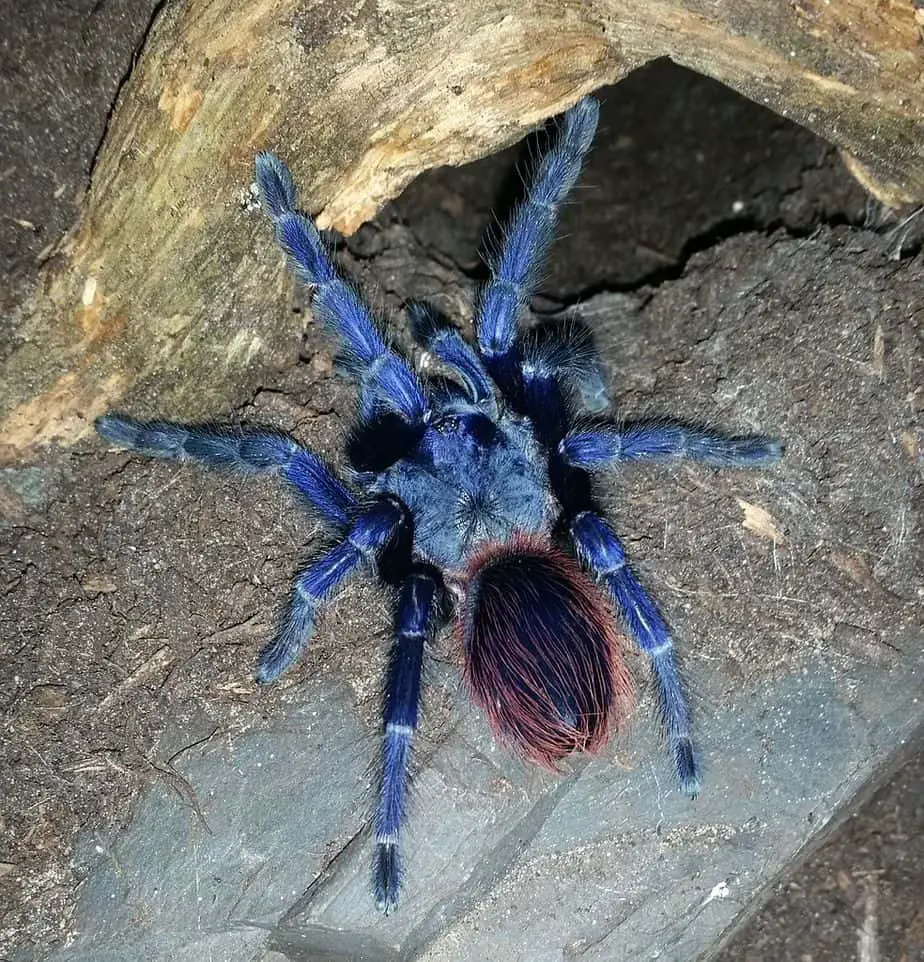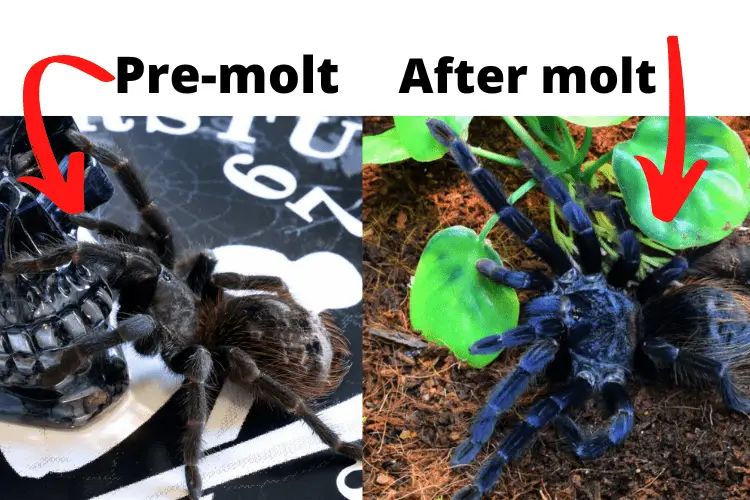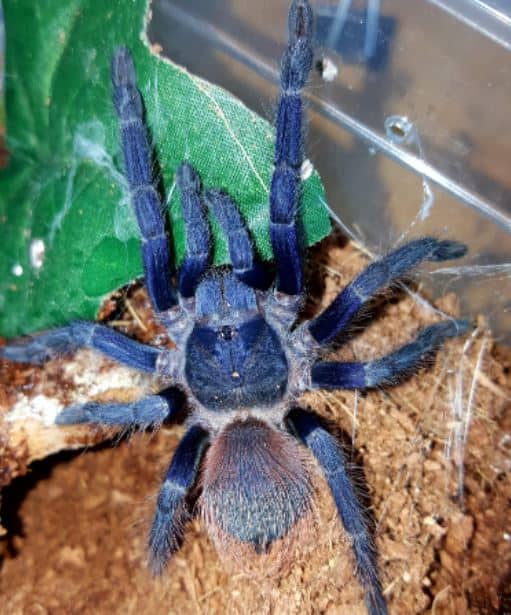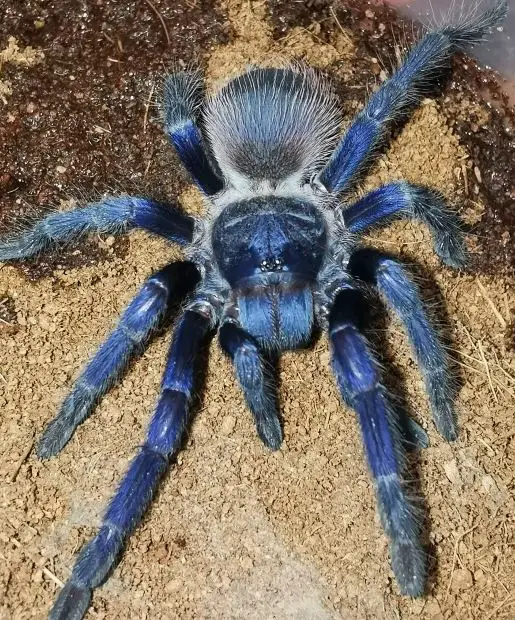The Brazilian Blue Tarantula (Pterinopelma sazimai) is a New World tarantula found in Brazil. The combination of bright blue and orange hairs makes this an appealing exhibition spider.
If you’re thinking about adding a new tarantula to your collection and this one caught your eye, or if you already have one and want to know how to care for it, here’s everything that you need to know about the Brazilian Blue!

Brazilian Blue Tarantula Care Sheet
| Species Name | Pterinopelma sazimai |
| Family Name | Theraphosidae |
| Common Name | Brazilian Blue Tarantula, Iridescent Blue Tarantula, Sazima’s tarantula |
| Category | New World |
| Type | Terrestrial |
| Native Location | Brazil |
| Leg Span | 5.5″ to 6″ (14-16 cm) |
| Growth Speed | Medium/fast |
| Urticating Hairs | Yes |
| Social | Solitary |
| Diet | Insects: crickets, roaches, mealworms, etc |
| Temperature | 70 to 75 Fahrenheit |
| Humidity | 60-70% |
| Life Expectancy | Inconclusive, females believed to live up to 12 years |
| Recommended Experience Level | Intermediate |
| Minimum tank size | 5-10 gallons; wider than thall |
Brazilian Blue Tarantula Overview
Also known as Iridescent Blue Tarantula, the Pterinopelma sazimai is a terrestrial opportunistic borrower. It’s a relatively new species that was only discovered in 2011!
She’s found in Brazil, particularly in Minas Gerais, Chapada Diamantina, and Bahia. This spider can be very skittish and nervous, but they’re not prone to bite, and their venom isn’t very strong.
They’re a very popular species because of the fantastic colors they display.
Appearance and variants

The Brazilian Blue Tarantula is famous for its blue body accompanied by orange hairs over its abdomen. However, the blue tones aren’t always evident, and it sometimes looks like it has a dark gray color instead.
The darker color is accentuated right before a molt, but the spider is blue again right after, especially under direct light. Take a look at the image above to get an idea of what the tarantula looks like right before molting and right after molting. It’s quite a striking difference!
Males and females look very similar. Males sometimes have a deeper blue while females have a lighter blue, but this isn’t always the case. The most reliable way to sex these spiders is by checking the inside of a molt.
Females are also typically larger than males and have a longer lifespan.
Price
Sadly, these spiders are an endangered species in their natural habitat, which drives their prices up. If you’re thinking about buying one, make sure you get it from a reputable vendor to make sure it was bred in captivity. Buying captive-bred ensures that your purchase does not contribute to further endangering the species.
A juvenile will go for around $40 no matter the sex, and male pre-adults and adults can be found for about $80.
Females are far more expensive, with sub-adults costing around $220 and adults usually rising to $600 each, making this spider quite pricey.
Behavior and Temperament

Brazilian Blue Tarantulas are known to be very skittish and nervous. They will shy away and often run from stimuli.
However, if they feel cornered, they will take a defensive position, kick out hair, and can even bite. Luckily, their bites are not all that threatening to humans unless you’re allergic.
Their urticating hairs can cause irritation when they make contact with the skin and it’s especially important that you avoid getting them in your eye. It’s for that reason that some experts recommended wearing protective glasses when interacting with this tarantula.
Brazilian Blues are timid spiders that prefer the comfort of their deep burrows, so she’ll spend most of her time underground. However, her beauty when she comes out makes it worth the wait to see her.
Caring for a Brazilian Blue Tarantula
Temperature and Humidity
The Brazilian Blue Tarantula is suited to cooler and damper environments. She’s comfortable with 70°-75° F and 60%-70% humidity.
To reach the desired humidity levels you can place an oversized water bottle in their enclosure. The evaporation will help increase the humidity.
Substrate
These opportunistic burrowers will be grateful to have enough space for a deep burrow. Spiderlings need around three inches of substrate to burrow, but adults require a layer of up to five or six inches deep.
They’re used to rainy climates, so the substrate must be kept damp but not too swampy. The material must be soft and good at keeping the moisture, especially for spiderlings, so it’s good to use mixes with sphagnum moss such as Jungle Mix and peat moss such as Creature Soil.
Once they’ve developed up to juveniles, it’s no problem to start mixing the substrate with coconut fiber to stretch out the mixture.
Tank
Just like all terrestrial spiders, Brazilian Blue Tarantulas need tanks that are wider than they are tall. These are heavy spiders not suited for heights that are in danger of harming themselves if they fall from an elevated place.
Due to their nervous nature, the Brazilian Blue Tarantula will appreciate places to hide, so make sure you place a piece of cork bark and/or artificial plants inside the tank for decoration and hiding.
Tanks of around three gallons are great for adults. They don’t need as much space because they’ll spend most of their time in their burrows.
Also, make sure the lid has a lock; sometimes these spiders are so jumpy that they’re known for leaving their tanks.
Social
The Brazilian Blue Tarantula is not a social spider and should be kept solitary. In the wild, they only interact with others to breed. Do not try to put two of them in the same enclosure as this will not end well.
If you’re interested in a communal setup, check out species that are capable of living communally like the Socotra Blue Baboon or the Trinidad Olive Tarantula.
Molting
The Brazilian Blue Tarantula has a medium-fast growth rate so they will molt relatively often. Especially when they’re young and growing quickly they will shed their old exoskeleton to make way for a bigger one quite frequently.
When they molt, they often refuse food and water for a few days prior. Once the molting process starts, try to not disturb your spider since this is a stressful time for them.
Watering
If there’s enough space, keeping a water dish inside the tank and making sure to refill it is the safest choice. If that’s impossible, dripping water down one of the tank’s walls twice a week should be enough to keep the Brazilian Blue Tarantula hydrated.
Diet and Feeding

Feeding the Brazilian Blue Tarantula is quite simple, it just means making sure she ate and taking away any uneaten remains to prevent mold and bacterial growth.
They won’t eat if they’re not hungry or about to molt, so make sure to take away the leftover food. However, wait at least one day before doing so, as they’re known for being in their burrows until nighttime when they’ll often come out and eat. The reason they do this is that they’re nocturnal. This is normal behavior.
Spiderlings should be fed twice a week with either a small cricket or a small roach. Juveniles can have two small cockroaches or two to three medium crickets once every week.
Adults should have six to eight large crickets or a large cockroach once every two weeks. If you see the abdomen going slimmer, increase the food frequency.
If, on the other side, the spider’s abdomen keeps getting bigger, reduce the frequency to make sure it’s not overfed. You should also wait seven days for juveniles and fourteen days for adults after a molt to ensure the fangs are hard enough to eat.
Health & Lifespan
The Brazilian Blue Tarantula is typically a strong and healthy species. However, since they’re so new (they were only discovered as recently as 2011), it’s not entirely certain how long their lifespan is. It’s estimated that females will live up to 12 years, but this is not entirely certain.
To keep them healthy, it’s important that they have a good climate in their enclosure, good food, and that you prevent mold and bacterial build-up.
Breeding a Brazilian Blue Tarantula
The first step is to ensure both spiders are well fed and under environmentally ideal circumstances. It’s advisable to plan the mating for one month after the female molts. If she molts between the mating and the laying, the male’s reproductive material is lost.
It’s a good idea to allow these spiders to mate more than once to make sure the genetic exchange is done. The egg sack should be laid four months after mating. Once that’s done, wait one month before retrieving the sack for incubation.
Keep in mind that breeding is not something that should be attempted by novices. Tarantulas can have hundreds of slings. If you’re inexperienced you can end up with hundreds of unwanted tarantulas that can be difficult to house. Leave the breeding to the experts.
Brazilian Blue Tarantula Facts
- The Pterinopelma sazimai was first described in 2011 by Rogerian Bertani.
- They spend a lot of time in their burrow.
- The spider was named after Ivan Sazima, a Brazilian zoologist.
Final words
Beginners to the tarantula hobby are probably better off looking for a different spider since the Brazilian Blue is quite skittish and nervous in nature. However, hobbyists that have slightly more experience and want to add a beautiful, colorful tarantula to their collection can definitely consider the Brazilian Blue.
These spiders are very popular amongst collectors, but it’s very important that you make sure that you only buy them from reputable breeders who sell captive-bred individuals. They are endangered in the wild, and it would be a tragedy to see them go extinct as a result of the pet trade.
They’re not suited to be handled, but they make a striking exhibition spider. We hope this guide taught you everything that you need to know about this beautiful New World tarantula.
- How Long Do American Eskimo Dogs Live? Important Factors and Care Tips - September 29, 2023
- Do American Bulldogs Need Grooming? Essential Tips and Care Guidelines - September 29, 2023
- Do Bengal Cats Enjoy Playing? Essential Tips for Keeping Them Active - September 29, 2023